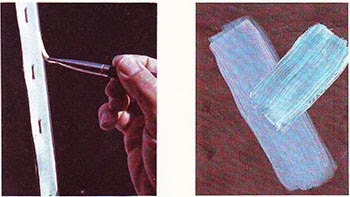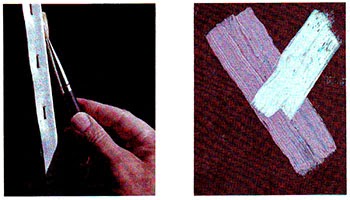Advertisement
Oil Painting Techniques
Oil paint is a very versatile medium. Anyone who paints in oils would do well to explore as many different techniques as possible. Some of them are bound to come in handy at times.
Don't worry about developing a technique of your own. It will come in time. lust keep studying and trying different techniques and palettes until you find a combination you're really comfortable with.
Eventually a style of your own will emerge and people will begin to recognize your work.
IMPROPER USE OF OIL PAINTS...Here the paint has been applied too thinly and spread too far. This method is useful only for uderpainting.
Improper use of oil paint - Get full of the medium
GET FULL USE OF THE MEDIUM...Oil paints are best applied at the consistency of soft butter, thick enough to cover well but not leave canvas texture exposed.
Wet in Wet Blending
WET IN WET...Oils are especially suitable for painting wet in wet (a wet layer over a still wet layer). it requires a soft touch and thick paint.
BLENDING...To blend different values or color lay them side by side, intermix them by running brush back and forth between them, and smooth with clean brush.
Small Details Painting Knife
SMALL DETAILS...A small round sable brush is used for details and often for sketching in the outline drawing. Try using one both flat and perpendicular to the canvas.
PAINTING KNIFE...Here are some stroke using a painting knife, from top to bottom using knife flat, using the edge of the knife and using the tip of the knife.
Scraping Out Wiping Out
SCRAPING OUT...Use sharpened end of brush to scrape out blades of grass, branches and twigs, trunks of far trees, and texture in bark. Paint layer must still be wet.
WIPING OUT...Starting with thinly applied paint, highlighted portion are wipe out with a clean rag wound on a finger or brush handle. use often in portrait.
Impressionist Scumbling
IMPRESSIONIST...Form or color masses are built up with short broken strokes or dabs of thick paint applied with brush or knife, then blended only slightly.
SCUMBLING...A thick layer of light tone can be loosely applied over a thin layer of dark tones by using a light touch and thick flat side of a fully loaded brush.
PROPER USE OF FLAT BRISTLE BRUSH
 Common Technique... Many artists hold their flat bristles as if they
Common Technique... Many artists hold their flat bristles as if they
were drawing with a pencil. This causes them to brush too deeply and spread the paint too thin.
Common Result...
The result is usually dull or muddy colors as the brush digs up the darker layer underneath. (The brush also wears much faster!)

Better Technique...
Hold the brush this way, (flat to the canvas) and use it fully loaded with thicker paint and apply with a very light touch.
Better Result...
The result should be cleaner, richer and brighter colors. (So much for so little!) Try this experiment and see for yourself.
SO TRY IT! THINK FLAT AND THINK THICK!
Oil paint is a very versatile medium. Anyone who paints in oils would do well to explore as many different techniques as possible. Some of them are bound to come in handy at times.
Don't worry about developing a technique of your own. It will come in time. lust keep studying and trying different techniques and palettes until you find a combination you're really comfortable with.
Eventually a style of your own will emerge and people will begin to recognize your work.
IMPROPER USE OF OIL PAINTS...Here the paint has been applied too thinly and spread too far. This method is useful only for uderpainting.
Improper use of oil paint - Get full of the medium
GET FULL USE OF THE MEDIUM...Oil paints are best applied at the consistency of soft butter, thick enough to cover well but not leave canvas texture exposed.
Wet in Wet Blending
WET IN WET...Oils are especially suitable for painting wet in wet (a wet layer over a still wet layer). it requires a soft touch and thick paint.
BLENDING...To blend different values or color lay them side by side, intermix them by running brush back and forth between them, and smooth with clean brush.
Small Details Painting Knife
SMALL DETAILS...A small round sable brush is used for details and often for sketching in the outline drawing. Try using one both flat and perpendicular to the canvas.
PAINTING KNIFE...Here are some stroke using a painting knife, from top to bottom using knife flat, using the edge of the knife and using the tip of the knife.
Scraping Out Wiping Out
SCRAPING OUT...Use sharpened end of brush to scrape out blades of grass, branches and twigs, trunks of far trees, and texture in bark. Paint layer must still be wet.
WIPING OUT...Starting with thinly applied paint, highlighted portion are wipe out with a clean rag wound on a finger or brush handle. use often in portrait.
Impressionist Scumbling
IMPRESSIONIST...Form or color masses are built up with short broken strokes or dabs of thick paint applied with brush or knife, then blended only slightly.
SCUMBLING...A thick layer of light tone can be loosely applied over a thin layer of dark tones by using a light touch and thick flat side of a fully loaded brush.
PROPER USE OF FLAT BRISTLE BRUSH
 Common Technique... Many artists hold their flat bristles as if they
Common Technique... Many artists hold their flat bristles as if they were drawing with a pencil. This causes them to brush too deeply and spread the paint too thin.
Common Result...
The result is usually dull or muddy colors as the brush digs up the darker layer underneath. (The brush also wears much faster!)

Better Technique...
Hold the brush this way, (flat to the canvas) and use it fully loaded with thicker paint and apply with a very light touch.
Better Result...
The result should be cleaner, richer and brighter colors. (So much for so little!) Try this experiment and see for yourself.
SO TRY IT! THINK FLAT AND THINK THICK!





No comments:
Post a Comment
"Thank you for reading my blog, please leave a comment"